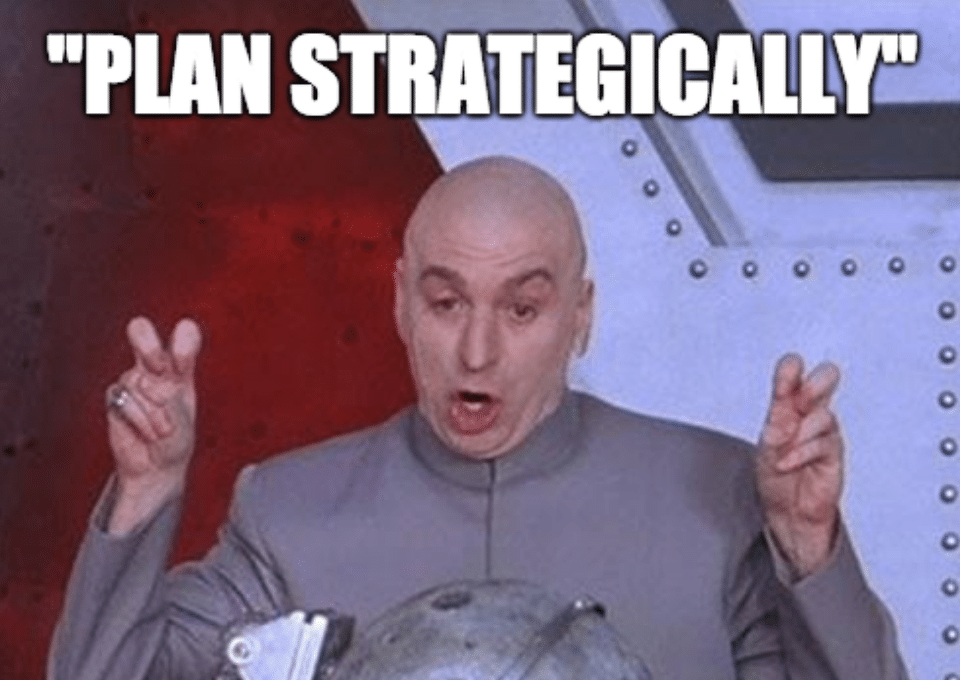Google ‘Marketing Budgets’ and you’ll find a tonne of reports that are all contradictory to one another, telling you how to allocate budget for digital marketing.
Some will shout Brexit at you, telling you to watch your step but still to invest.
Others will talk about oversaturation in almost every market and how now is the time to differentiate yourselves: “Spend, spend spend!”
The fact is, you can do as much reading as you want, there’s just no simple answer to the big question:
“What should my marketing budget be?”
I mean, how relevant are general trend reports to any specific business, anyway?
You might see that “brands increased their budgets at the slowest rate (2.5%) for almost three years in the third quarter of 2018*” – but what if brands in your sector bucked that trend?
You can read every single report out there, and you still might be none the wiser.

You don’t want to pluck a figure out of thin air.
What you’re looking for is a simple, mathematically-sound method to help you identify how much you should be spending on marketing.
There is a general rule of thumb taught at many universities and quoted by business mentors and entrepreneurs across the world is that your marketing spend should be 5% of turnover to maintain your market position and 10% of turnover to grow.
But my issue with this is that there are so many variables involved, how can any business follow a ‘general rule of thumb’?
- What if your industry is in decline? You need to fight harder for every customer (either to win them or retain them)
- What if your industry is in a growth phase? You need to ensure you ride the wave and land grab while you can
- What if you work in a really niche industry – should you spend more or less than the rule of thumb?
- What if you’re entering new markets or have a new product?
- What if your brand awareness is low or there’s a poor perception of you in the market?
So, what are your options?
You could spend nothing…
- Your investment in marketing last year didn’t provide the return you wanted, so you decide you don’t need marketing
- If this was the case, chances are your strategy wasn’t right.
- Doing nothing is a short-term view – your business will lose out in the long run as your competitors take the market and take up more market share.
You could spend what you’ve always spent…
- “It worked last year – let’s just stick to the same!”

- But is this ambitious enough? Don’t you have bigger plans for growth than last year?
- Will it keep you in the game alongside the competition?
- Will the messages, tactics and channels still resonate with your target audience or have they reached saturation point?
- “The definition of insanity is doing the same thing over and over again and expecting different results” Albert Einstein.
You could stick your finger in the air…
You want next year to be better than last, so you increase your marketing budget.
- But by how much?
- Do you even need to increase it? What if you spent it more wisely and got more from your spend?
- More spend does not guarantee more new business.
Or maybe – just maybe – you could plan strategically:

Forget guesswork, habit and general trends – to work out how to allocate budget for digital marketing, you need to outline your financial objectives and exactly what you want to achieve.
As with anything in life, nothing is simple. The number of variables involved in planning a budget are huge. That said, with the right, strategic process, you’ll get a good, ballpark figure to go from.
If it’s out of your league, chances are you’re either trying to grow too quickly, your cost per acquisition is too high or your close rate is too low.
Anyway, without further ado, this is how we’d recommend going about your marketing budget planning.
A Simple Process to Allocate Budget for Digital Marketing
Step 1: Evaluate
Look at your marketing and sales metrics for the last 12 months. They will have a lot of the information you’ll need to evaluate in marketing budget planning for the next year.
Some of the key things you’ll want to look at are:
- Total marketing spend
- Total number of enquiries
- Total number of new customers
- Total revenue from new customers
That said, don’t solely rely on cold, hard data. Clever budget planning requires a balance between left brain analytics and right brain knowledge.
Speak to your staff about what they think went right and wrong, where they think spend was wasted and could’ve been better invested.
Often, your team as a whole already knows the answers, you just have to ask the questions.
Step 2: Do Some Maths
Next you’ll need to divide your total revenue by the number of customers to get the average spend per customer.
It’s also worth looking at your revenue growth against the number of new deals that were done last year – both for new customers and existing ones.
Another calculation you might want to look at would be how much of your revenue can be attributed to new customers vs existing customers simply increasing their spend.
This will give you a good picture of the overall financial landscape in your business.
Step 3: Set Your Goals
This is the most important part of any budget. If you don’t know where you’re going, how on earth will you know when you get there?
Start by identifying how much you want to increase your revenue by in 2019.
And don’t just say 100000%.
Goals need to be realistic and measurable, taking into account the opportunity in the market, as well as how much you can actually spend to achieve it.
You’d be amazed how many potential clients come to us and say they want to grow the business by £20m but only want to spend £5k to get there.

We might be good, but nobody’s that good!
Once you’ve worked out how much you want to increase revenue by as a number (not a percentage), divide this by the average spend per customer, as worked out in step 2.
This will give you the number of new customers you need to win to achieve the growth in revenue.
Step 4: Finalise
Take your total marketing spend in 2018 and divide it by the number of new customers you acquired last year.
This will give you the cost per acquisition of a new customer.
Now, if you multiply that by the number of new customers you need to achieve your revenue growth identified in step 3, you should get a ballpark marketing budget for 2019, set against your goals.
In Summary
You’ll notice in the steps above I’ve used the term ‘new customer’ a fair few times.
Let’s not forget that there will, of course, be revenue coming in from repeat and retained business too. So, with both new and existing customers in mind, here a few other considerations you’ll need to make:
- Gather insight into your industry. You could be as formal as conducting a PEST analysis, looking at any external Political, Economical, Social and Technological factors that could impact your objectives. Or, if you’re in a well reported industry, you could just look at the news.
- Look at the competition. Is there anything you can learn or avoid based on what they’ve done? Are new ones entering the market that could pose a threat?
- What could you do better from your own perspective? It’s possible that you’re doing everything possible to generate and close your leads. But if you’re honest, you’re probably not. What could you improve on? What are the skills missing in your team? Where do the gaps in your knowledge lie?
- Speak to your customers, prospects and lost deals. Why did you win? Why do they continue to use you? Why did you lose them? These insights ensure that your messages and offering moving into 2019 are centered around your customers and potential customers. Remember: your most unhappy customers are your greatest source of learning.
- Is your business geared for growth? If you were to get loads of marketing qualified leads in next year, would you be able to close them? Can your operations team deal with more demand? Marketing alone often doesn’t achieve growth for businesses for these reasons. Aligning your operations, sales and marketing strategies ensures your entire business is set up for growth and any marketing strategy you implement deliver a return.
As we said at the start, there’s no easy or clear cut way to define your budget. Even if you do define one, we can almost guarantee you’ll spend less or more than the final figure you come up with.
It could be that, due to poor spend, you actually spend less than last year but get more new business off the back of it.
It’s incredibly important to get a budget down on paper which is set against specific goals in order to make sure you can actually afford to achieve the growth you dream of.
If you need some further help and advice, feel free to get in touch with us; we help SMEs from all manner of industries to implement growth strategies that generate leads, get bums on seats, convert opportunities and retain customers.
If you’d like an expert opinion on your goals for growth, click here to get in touch.
Subscribe to Our Blog

